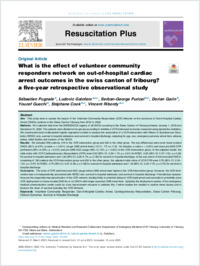What is the effect of volunteer community responders network on out-of-hospital cardiac arrest outcomes in the swiss canton of fribourg? a five-year retrospective observational study
DOKPE
- Pugnale, Sébastien University and Teaching Hospital, Fribourg, Switzerland
- Galofaro, Ludovic ORCID University of Fribourg
- Puricel, Serban-George University of Fribourg
- Garin, Dorian University and Teaching Hospital, Fribourg, Switzerland
- Guechi, Youcef University and Teaching Hospital, Fribourg, Switzerland
- Cook, Stéphane ORCID University of Fribourg
- Ribordy, Vincent ORCID University of Fribourg
- 2025
Published in:
- Resuscitation Plus. - Elsevier BV. - 2025, vol. 25, p. 1-10
Volunteer Community Responder
Out-of-Hospital Cardiac Arrest
Cardiopulmonary Resuscitation
Swiss Canton Fribourg
Clinical Outcomes
Survival to Hospital Discharge
English
Aim: This study aims to assess the impact of the Volunteer Community Responders (VCR) Network on the outcomes of Out-of-hospital Cardiac Arrest (OHCA) patients in the Swiss Canton Fribourg from 2018 to 2022.
Methods: We collected data from the SWISSRECA registry of all OHCA occurring in the Swiss Canton of Fribourg between January 1, 2018 and December 31, 2022. The patients were divided in two groups according to whether a VCR intervened and were compared using descriptive statistics. We constructed exact multivariable logistic regression models to analyse the association of a VCR intervention with Return of Spontaneous Circulation (ROSC) rate, survival to hospital admission and survival to hospital discharge, adjusting for age, sex, emergency services arrival time, witness status, initial rhythm and location of the OHCA.
Results: We included 559 patients, 319 in the VCR intervention group and 240 in the other group. The key differences were more home located OHCA (80% vs 63%; p-value = < 0.001), longer EMS arrival times (13 [11, 17] vs 11 [8, 14] minutes; p-value = < 0.001) and more pre-EMS CPR performed (95% vs 63%; p < 0.001) and pre-EMS AED usage (48% vs 13%; p < 0.001) in the VCR intervention group. In the adjusted model, the odds ratios with VCR Cardiopulmonary Resuscitation (CPR) were 0.82 (95% CI: 0.39–1.74; p = 0.61) for ROSC, 0.65 (95% CI: 0.27–1.53; p = 0.32) for survival to hospital admission and 1.22 (95% CI: 0.26–5.74; p = 0.80) for survival to hospital discharge. In the sub-cohort of home-located OHCA, consisting of 192 patients the VCR intervention group and 202 in the other group, the adjusted odds ratios of VCR CPR were 0.78 (95% CI: 0.34–1.81; p = 0.57) for ROSC, 0.75 (95% CI: 0.27–2.08; p = 0.58) for survival to hospital admission and 1.34 (95% CI: 0.23–7.79; p = 0.75) for survival to hospital discharge.
Conclusion: The rates of CPR performed and AED usage before EMS arrival were higher in the VCR intervention group. However, the VCR intervention was not independently associated with ROSC rate, survival to hospital admission and survival to hospital discharge. Potential key explanations are the sequential manual activation of the VCR network, leading firstly to potential delays in VCR deployment and secondly to potentially more VCR deployment on home-located OHCAs or on OHCA with longer expected EMS travel time. Updating the deployment system of the emergency medical communication centre could be a key improvement measure to address this. Further studies are needed to explore these issues and to improve the chain of survival including the VCR Network.
Methods: We collected data from the SWISSRECA registry of all OHCA occurring in the Swiss Canton of Fribourg between January 1, 2018 and December 31, 2022. The patients were divided in two groups according to whether a VCR intervened and were compared using descriptive statistics. We constructed exact multivariable logistic regression models to analyse the association of a VCR intervention with Return of Spontaneous Circulation (ROSC) rate, survival to hospital admission and survival to hospital discharge, adjusting for age, sex, emergency services arrival time, witness status, initial rhythm and location of the OHCA.
Results: We included 559 patients, 319 in the VCR intervention group and 240 in the other group. The key differences were more home located OHCA (80% vs 63%; p-value = < 0.001), longer EMS arrival times (13 [11, 17] vs 11 [8, 14] minutes; p-value = < 0.001) and more pre-EMS CPR performed (95% vs 63%; p < 0.001) and pre-EMS AED usage (48% vs 13%; p < 0.001) in the VCR intervention group. In the adjusted model, the odds ratios with VCR Cardiopulmonary Resuscitation (CPR) were 0.82 (95% CI: 0.39–1.74; p = 0.61) for ROSC, 0.65 (95% CI: 0.27–1.53; p = 0.32) for survival to hospital admission and 1.22 (95% CI: 0.26–5.74; p = 0.80) for survival to hospital discharge. In the sub-cohort of home-located OHCA, consisting of 192 patients the VCR intervention group and 202 in the other group, the adjusted odds ratios of VCR CPR were 0.78 (95% CI: 0.34–1.81; p = 0.57) for ROSC, 0.75 (95% CI: 0.27–2.08; p = 0.58) for survival to hospital admission and 1.34 (95% CI: 0.23–7.79; p = 0.75) for survival to hospital discharge.
Conclusion: The rates of CPR performed and AED usage before EMS arrival were higher in the VCR intervention group. However, the VCR intervention was not independently associated with ROSC rate, survival to hospital admission and survival to hospital discharge. Potential key explanations are the sequential manual activation of the VCR network, leading firstly to potential delays in VCR deployment and secondly to potentially more VCR deployment on home-located OHCAs or on OHCA with longer expected EMS travel time. Updating the deployment system of the emergency medical communication centre could be a key improvement measure to address this. Further studies are needed to explore these issues and to improve the chain of survival including the VCR Network.
- Faculty
- Faculté des sciences et de médecine
- Department
- Master en médecine
- Language
-
- English
- Classification
- Medicine
- License
- Open access status
- gold
- Identifiers
-
- DOI 10.1016/j.resplu.2025.101009
- ISSN 2666-5204
- Persistent URL
- https://folia.unifr.ch/unifr/documents/332413
Statistics
Document views: 58
File downloads:
- main: 42
